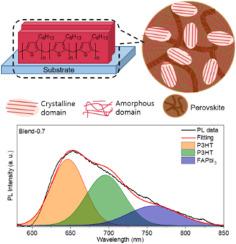Our official English website, www.x-mol.net, welcomes your feedback! (Note: you will need to create a separate account there.)
Charge transport and ion migration in perovskite-incorporated conjugated polymer semiconductor
Polymer ( IF 4.6 ) Pub Date : 2024-03-11 , DOI: 10.1016/j.polymer.2024.126903 Benjamin Nketia-Yawson , Vivian Nketia-Yawson , Albert Buertey Buer , Ji Hyeon Lee , Hyungju Ahn , Jea Woong Jo
Polymer ( IF 4.6 ) Pub Date : 2024-03-11 , DOI: 10.1016/j.polymer.2024.126903 Benjamin Nketia-Yawson , Vivian Nketia-Yawson , Albert Buertey Buer , Ji Hyeon Lee , Hyungju Ahn , Jea Woong Jo

|
The migration of intrinsic ions in metal halide perovskites and their interfaces has been shown to contribute to hysteresis and performance degradation in perovskite-based electronic devices, particularly in photovoltaics and transistors. Accordingly, controlling the film morphology, microstructure, and ionic defects in perovskite semiconductors is essential for advancing and achieving high-performance perovskite field-effect transistors (FETs). In this study, we demonstrate a well-controlled method to systematically probe the structure-property relationships, origin of hysteresis, and intrinsic ion migration effects in formamidinium iodide and lead iodide (FAI + PbI)-based perovskite by incorporating it in a semicrystalline conjugated poly(3-hexylthiophene) (P3HT) polymer. Optimized FETs exhibited over 100% hole mobility enhancement owing to unperturbed edge-on crystalline orientation of the P3HT chains caused by the incorporated perovskite, P3HT-(FAI + PbI) interactions, and better charge injection properties. However, the optimized devices exhibited improved current modulation with dual-sweep hysteresis, which was attributed to the ion migration effect contributed by the polarization of the lead/iodine-related ions and defects. Furthermore, operational stability investigation of the P3HT-(FAI + PbI) FETs in the air revealed gradual current decay owing to charge trapping in contrast to the control P3HT FETs. This work provides a fundamental understanding of the origin of hysteresis and instabilities in metal perovskite materials and their transistor-based devices.
中文翻译:

钙钛矿共轭聚合物半导体中的电荷传输和离子迁移
金属卤化物钙钛矿及其界面中本征离子的迁移已被证明会导致基于钙钛矿的电子器件(特别是光伏器件和晶体管)的磁滞和性能下降。因此,控制钙钛矿半导体中的薄膜形态、微观结构和离子缺陷对于推进和实现高性能钙钛矿场效应晶体管(FET)至关重要。在这项研究中,我们展示了一种良好控制的方法,通过将其纳入半晶共轭钙钛矿中,系统地探讨碘化甲脒和碘化铅(FAI + PbI)基钙钛矿的结构-性能关系、滞后起源和固有离子迁移效应。聚(3-己基噻吩) (P3HT) 聚合物。优化的 FET 表现出超过 100% 的空穴迁移率增强,这是由于掺入的钙钛矿、P3HT-(FAI + PbI) 相互作用导致 P3HT 链边缘晶体取向不受干扰,并且具有更好的电荷注入特性。然而,优化的器件表现出具有双扫描磁滞的改进的电流调制,这归因于铅/碘相关离子和缺陷的极化所造成的离子迁移效应。此外,对 P3HT-(FAI + PbI) FET 在空气中的运行稳定性研究表明,与对照 P3HT FET 相比,由于电荷捕获,电流逐渐衰减。这项工作提供了对金属钙钛矿材料及其基于晶体管的器件的磁滞和不稳定性起源的基本理解。
更新日期:2024-03-11
中文翻译:

钙钛矿共轭聚合物半导体中的电荷传输和离子迁移
金属卤化物钙钛矿及其界面中本征离子的迁移已被证明会导致基于钙钛矿的电子器件(特别是光伏器件和晶体管)的磁滞和性能下降。因此,控制钙钛矿半导体中的薄膜形态、微观结构和离子缺陷对于推进和实现高性能钙钛矿场效应晶体管(FET)至关重要。在这项研究中,我们展示了一种良好控制的方法,通过将其纳入半晶共轭钙钛矿中,系统地探讨碘化甲脒和碘化铅(FAI + PbI)基钙钛矿的结构-性能关系、滞后起源和固有离子迁移效应。聚(3-己基噻吩) (P3HT) 聚合物。优化的 FET 表现出超过 100% 的空穴迁移率增强,这是由于掺入的钙钛矿、P3HT-(FAI + PbI) 相互作用导致 P3HT 链边缘晶体取向不受干扰,并且具有更好的电荷注入特性。然而,优化的器件表现出具有双扫描磁滞的改进的电流调制,这归因于铅/碘相关离子和缺陷的极化所造成的离子迁移效应。此外,对 P3HT-(FAI + PbI) FET 在空气中的运行稳定性研究表明,与对照 P3HT FET 相比,由于电荷捕获,电流逐渐衰减。这项工作提供了对金属钙钛矿材料及其基于晶体管的器件的磁滞和不稳定性起源的基本理解。



























 京公网安备 11010802027423号
京公网安备 11010802027423号